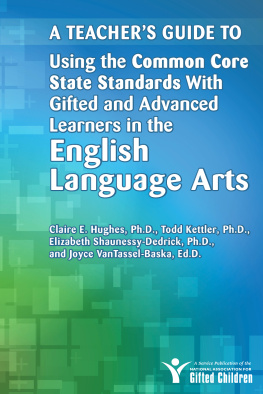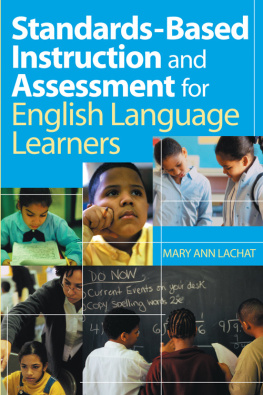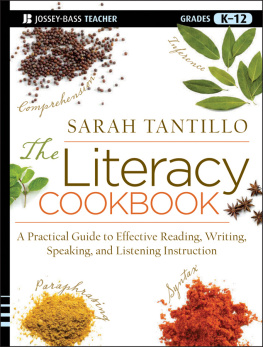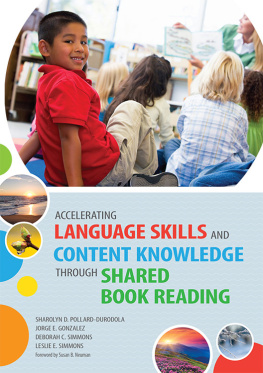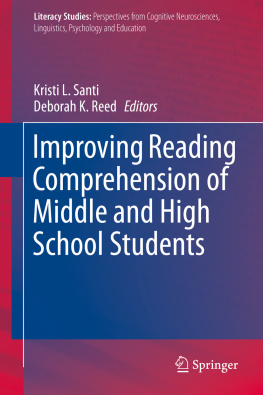
Copyright 2011 by Solution Tree Press
All rights reserved, including the right of reproduction of this book in whole or in part in any form.
555 North Morton Street
Bloomington, IN 47404
800.733.6786 (toll free) / 812.336.7700
FAX: 812.336.7790
email:
solution-tree.com
Printed in the United States of America
15 14 13 12 11 1 2 3 4 5

Library of Congress Cataloging-in-Publication Data
Caldern, Margarita.
Teaching reading and comprehension to English learners, K5 / Margarita Caldern.
p. cm.
Includes bibliographical references.
ISBN 978-1-935542-03-2 (perfect bound) -- ISBN 978-1-935542-04-9 (library edition)
1. English language--Study and teaching (Elementary)--United States--Foreign speakers. 2. Second language acquisition--United States. 3. Multiculturalism--United States. I. Title.
PE1128.A2C24 2011
372.4--dc22
2011004292

Solution Tree
Jeffrey C. Jones, CEO & President
Solution Tree Press
President: Douglas M. Rife
Publisher: Robert D. Clouse
Vice President of Production: Gretchen Knapp
Managing Production Editor: Caroline Wise
Senior Production Editor: Lesley Bolton
Proofreader: Elisabeth Abrams
Text and Cover Designer: Jenn Taylor
ACKNOWLEDGMENTS
There are so many fantastic folks to thank for inspiring this publication!
Teachers and administrators from: New York City schools, in particular MS 319, PS 46, PS 279, and all new RIGOR and ExC-ELL schools; North Carolina State Department of Education Title III Office and the many ExC-ELL schools throughout the state; Region 1 Education Service Center in Texas and schools in the region; Kauai schools and central office; Granite School District ELL Office, Granite Park MS, and Granite schools; Yupiit School District and schools; and Washington, DC schools.
My mentors and friends: Dr. Robert Slavin, director of the Center for Research and Reform in Education at Johns Hopkins University, who has guided and inspired my research; Andrs Henrquez, program officer of the Urban Education National Program at the Carnegie Corporation of New York, who believed in this project and funded it for five years; Rebecca Fitch and Tim DEmilio of the U.S. Department of Education, whose advice and friendship have always encouraged my work with schools; my best friends and associates who have worked side by side with me in all our professional development efforts in schools, Liliana Minaya-Rowe, Mara Trejo, Argelia Carren, Elma Noyola, Flo Decker, Jeanne Cant, Ana Bishop, Lupita Espino, and Lili Trillo; and, of course, Robb Clouse, who kept insisting that I write this book.
Solution Tree Press would like to thank the following reviewers:
Timothy Boals
Executive Director
World-Class Instructional Design and Assessment Consortium
Madison, Wisconsin
Regina Boyd
English as a Second Language Program Specialist
Charlotte-Mecklenburg Schools
Charlotte, North Carolina
Argelia Carren
Educational Consultant, Former Director of Bilingual Education and
Accelerated Learning
El Paso Independent School District
El Paso, Texas
Crystal Dawn Cook
English Language Learner Teacher
Egypt Elementary
Memphis, Tennessee
Cindy Craft
Resource Teacher
San Diego Unified School District
San Diego, California
Trisha Ganey
First Grade Teacher
North Bay Elementary
Biloxi, Mississippi
Charlene Lui
Director, Educational Equity
Granite School District
Salt Lake City, Utah
Timothy McKay
English as a Second Language Director
Pittsburgh Public Schools
Pittsburgh, Pennsylvania
J. Sabrina Mims-Cox
Professor of Education
California State University, Los Angeles
Los Angeles, California
TABLE OF CONTENTS
The Diversity of Students and Programs
RTI and Quality Instruction
The Educational Needs of Young ELs
The Most Critical Year: First Grade
Selecting Words to Teach
Teaching Vocabulary
Teaching Reading
Teaching Writing
Ensuring and Reinforcing Comprehension
Cooperative Learning
ABOUT THE AUTHOR

Margarita Caldern, PhD, is professor emerita and senior research scientist at the Johns Hopkins University School of Education. She has conducted research, training, and curriculum development for teaching language, reading comprehension, and content knowledge to K12 English learners. Her work has focused on effective instructional processes, two-way and dual-language programs, teacher learning communities, and professional development for schools with language minority populations and striving adolescent readers. Dr. Calderns research has been supported by the Carnegie Corporation of New York, U.S. Department of Education, U.S. Department of Labor, National Institutes of Health, and the Texas Education Agency.
A native of Jurez, Mexico, Dr. Caldern is a recognized expert in education with more than one hundred publications to her credit. She is a respected member of several panels and national committees, and she has been welcomed internationally as a visiting lecturer. Dr. Caldern has created and directed her own international institutes for administrators, teachers, and parents. She has experience as a classroom teacher, bilingual program director, professional development coordinator, professor of educational leadership graduate programs, and teacher supervisor.
Dr. Caldern earned a doctorate in educational management, applied linguistics, and organizational development through a joint PhD program at Claremont Graduate University and San Diego State University.
INTRODUCTION
Greater numbers of English learners (ELs) are enrolled in school every year. (The U.S. Department of Education officially calls these students limited English proficient [LEP] students. They are also sometimes referred to as language minority students [LMS]). Teachers and administrators are concerned with the large gap in reading and academic standing between ELs and students performing at grade level and want to know how to provide quality instruction to help close this gap.
My colleagues and I have completed several longitudinal studies in preschool to grade 12 and analyzed others while participating in national research panels. In doing so, we have accumulated a collection of school-based and instructional features that are working for all students. These features have been integrated and empirically tested in a professional development model called Expediting Comprehension for English Language Learners (ExC-ELL) through funding from the Carnegie Corporation of New York. We have since offered ExC-ELL professional development programs and on-site follow-up activities in various schools, school districts, regional educational centers, state departments of education, and universities for teams of teachers, coaches, and administrators. With this book, we are now bringing this information to you. Each chapter emphasizes the features that have had the greatest impact on EL success.
Next page

